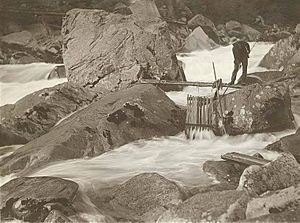Wenatchi facts for kids
| np̓əšqʷáw̓səxʷ | |
|---|---|
| Regions with significant populations | |
| Languages | |
| English, Salishan, Interior Salish | |
| Related ethnic groups | |
| Colville, Sanpoil, Nespelem, Palus, Sinixt, Entiat, Methow, Southern Okanagan, Sinkiuse-Columbia, and the Nez Perce of Chief Joseph's band |
The Wenatchi people, also known as Šnp̍əšqʷáw̉šəxʷi or Np̓əšqʷáw̓səxʷ, are a group of Native Americans. Their name means "People in the between." They originally lived in central Washington state, near where the Columbia and Wenatchee Rivers meet.
They spoke Interior Salish, which is a type of Salish language. The Wenatchi people traditionally ate salmon, starchy roots like camas and biscuitroot, and berries. They also hunted animals such as deer and sheep. The Wenatchee River was a very important food source because it had many salmon. However, dams and pollution later affected the salmon runs.
Contents
Wenatchi History
The name "Wenatchi" comes from the neighboring Yakama people. They called a fishing spot "Winátsha" and the Wenatchi group there "Winátshapam," meaning "People at Winátsha." The Wenatchi people themselves called this group "Sinpusqôisoh." This is why they were also known as "P'squosa" or "Pisquouse" in the past.
Wenatchi Bands and Related Groups
The Wenatchi people were made up of several distinct groups, or bands. These included:
- The Stsilámuh: These were the "People at the Deep Water," living near Lake Chelan.
- The Sintiátqkumuh: These were the "People from the place of grassy water," living along the Entiat River.
- The Siniálkumuh: They lived on the Columbia River, between the Entiat and Wenatchee Rivers.
- The Sinkumchímulh: These were the "People at the mouth of the Wenatchee River."
- The Sinhahamchímuh: They lived further up the Wenatchee River.
- The Sinpusqôisoh: This group lived where the Wenatchee River forks, near where the town of Leavenworth, Washington, is today.
The Wenatchi people were closely connected to the Entiat and Chelan peoples through their language. They also shared culture and intermarried with Upper Yakima bands. Sometimes, the Chelan and Entiat peoples were even considered to be part of the Wenatchi.
Changes Over Time
Before horses arrived, the Wenatchi tribe was quite isolated. But after they got horses, they started to adopt many traditions and clothing styles from the Plains Indians. By the time white settlers arrived, the Wenatchi were close allies with the Spokane tribes.
Sadly, it's believed that about 90% of the Native American population in the area died before white settlers even arrived. This was due to infectious diseases that spread quickly, often carried by horses, long before direct contact.
Wenatchi Land and Treaties
The Wenatchi people were not given reservation land by the U.S. government. Even though they had signed a treaty, it was never officially recognized. As more settlers moved into their territory, their claims to the land were ignored.
Unlike many other tribes, the Wenatchi did not fight with the new settlers. In fact, they were friendly with the first white families who arrived. One early settler, Janie Hollingsworth, born in 1911, remembered growing up happily with the daughter of the Wenatchi Chief. They rode horses together in the Nahahum Canyon area. However, the government later decided to move all Native Americans to existing reservations. Today, most Wenatchi people live on the Colville Indian Reservation, with a smaller number on the Yakama Reservation.
Wenatchapam Fishery
The Wenatchapam Fishery is a very important cultural place for the Wenatchi people. It is located in the Wenatchee National Forest, where the Wenatchee River and Icicle Creek meet, near Leavenworth.
This fishery was named as a reservation site in the Yakama treaty from the Walla Walla Council (1855). Its boundaries were surveyed by the Army in the years that followed. After the Colville Indian Reservation was created and lands were reassigned, Wenatchi Chief John Harmelt worked with Chief Joseph of the Nez Perce people to ask the government to protect the Wenatchi's rights to the fishery.
However, more white settlers moved into the area, taking over land that the Wenatchi claimed. Also, the Great Northern Railway was allowed to build a train route right through the reserved land.
Losing the Fishery
In 1893, another survey was ordered. But a government agent named L.T. Erwin, who sided with the settlers and the railroad company, interfered. He tried to offer Chief Harmelt small plots of land in the mountains for the remaining Wenatchi people. Chief Harmelt wanted to talk to his people before making a decision.
While Chief Harmelt was away, Erwin falsely told the Yakama tribal leaders that the Wenatchi had sold their land rights. Believing this, the Yakama then sold their share of the land for $20,000. This led to the Wenatchi people losing their important fishery.


